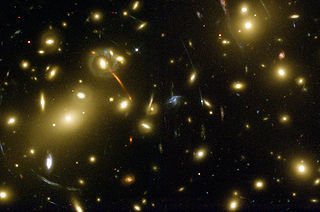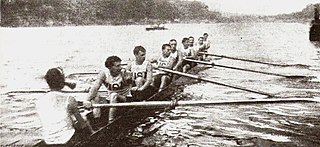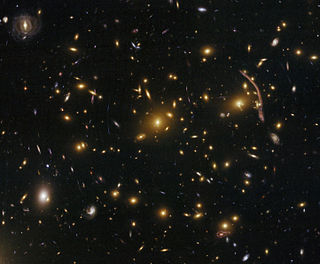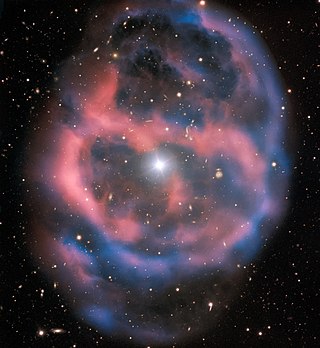Related Research Articles
George Ogden Abell was an American educator. Teaching at UCLA, priorly he worked as a research astronomer, administrator, as a popularizer of science and of education, and as a skeptic. He earned his B.S. in 1951, his M.S. in 1952 and his Ph.D. in 1957, all from the California Institute of Technology. He was a Ph.D. student under Donald Osterbrock. His astronomy career began as a tour guide at the Griffith Observatory in Los Angeles. Abell made great contributions to astronomical knowledge which resulted from his work during and after the National Geographic Society - Palomar Observatory Sky Survey, especially concerning clusters of galaxies and planetary nebulae. A galaxy, an asteroid, a periodic comet, and an observatory are all named in his honor. His teaching career extended beyond the campus of UCLA to the high school student oriented Summer Science Program, and educational television. He not only taught about science but also about what is not science. He was an originating member of the Committee on Scientific Investigation of Claims of the Paranormal now known as the Committee for Skeptical Inquiry.

Abell 2218 is a large cluster of galaxies over 2 billion light-years away in the constellation Draco.

Abell 1835 IR1916 was a candidate for being the most distant galaxy ever observed, although that claim has not been verified by additional observations. It was claimed to lie behind the galaxy cluster Abell 1835, in the Virgo constellation.

Abell 1835 is a galaxy cluster in the Abell catalogue. It is a cluster that also gravitational lenses more-distant background galaxies to make them visible to astronomers. The cluster has a red shift of around 75,900 km/s and spans 12′.

Abell 2029 or A2029 is a large and relaxed cluster of galaxies 315 megaparsecs away in the constellation Virgo. A2029 is a Bautz–Morgan classification type I cluster due to its large central galaxy, IC 1101. Abell 2029 has a diameter of 5.8–8 million light-years. This type of galaxy is called a cD-type brightest cluster galaxy and may have grown to its large size by accreting nearby galaxies. Despite its relaxed state, it is the central member of a large supercluster which shows clear signs of interaction.

52P/Harrington–Abell is a periodic comet in the Solar System.

Abell 400 is a galaxy cluster which contains the galaxy NGC 1128 with two supermassive black holes spiraling towards merger.

Abell 1689 is a galaxy cluster in the constellation Virgo over 2.3 billion light-years away.

Earl C. "Tuffy" Abell was an American college football player and coach. He played football as a tackle at Colgate University. He later returned to Colgate as an assistant coach in 1925, and took over the head coaching job in 1928. He spent the 1929 and 1930 football seasons as head football coach at the University of Virginia. Abell was inducted into the College Football Hall of Fame as player in 1973.

Louis Grenville Abell was an American rower who competed in the 1900 Summer Olympics and in the 1904 Summer Olympics.

Abell 370 is a galaxy cluster located nearly 5 billion light-years away from the Earth, in the constellation Cetus. Its core is made up of several hundred galaxies. It was catalogued by George Abell, and is the most distant of the clusters he catalogued.

Abell 2147 is a galaxy cluster in the Abell catalogue. It is located within the core of the Hercules Superclusters, within Serpens Caput, near the cluster Abell 2152, approximately two degrees south southwest of the Hercules Cluster. It is possible that Abell 2147 is actually part of the Hercules Cluster considering that it shares the same redshift of 550 million light years.
Abell 133 is a galaxy cluster in the Abell catalogue.

Abell 262 is a galaxy cluster in the Abell catalogue. It is part of the Perseus–Pisces Supercluster, one of the largest known structures in the universe. Although its central galaxy, NGC 708, is a giant cD galaxy, most of its bright galaxies are spirals, which is unusual for a galaxy cluster. With approximately 200 members it is a comparatively small cluster.
Abell 1795 is a galaxy cluster in the Abell catalogue.
Abell 222 is a galaxy cluster in the constellation of Cetus. It holds thousands of galaxies together. It is located at a distance of 2.4 billion light-years from Earth.
Abell 223 is a galaxy cluster. It is located at a distance of 2.4 billion light-years from Earth. The cluster is connected to nearby cluster Abell 222 by a filament of matter. Research has shown that only 20% of that matter is normal. The rest is thought to be dark matter. This means that this would form the Abell 222/ Abell 223 Supercluster as we understand them.

Abell 70 is a slightly elongated planetary nebula located 13,500-17,500 light years away in the constellation of Aquila. It is approaching the earth at 79 kilometers per second and expanding 38 kilometers per second. There is a galaxy named PMN J2033-0656 behind Abell 70, giving it a "diamond ring" effect.

Abell 36 is a faint barrel shaped planetary nebula located 780 light years from Earth in the constellation of Virgo. It was discovered by the American astronomer George Ogden Abell in 1955.

Draco Supercluster (SCL 114) is a galaxy supercluster in the constellation Draco. It is located at a distance of 300 Mpc h−1 on a side of a void of diameter of about 130 Mpc h−1. The near side of the void is bordered by the Ursa Major supercluster. The estimated size of the supercluster reaches 410 million light years and a mass of 1017 M☉, making it one of the largest and most massive superclusters known in the observable universe.
References
- 1 2 Pan, Zhizheng; Yuan, Qirong; Kong, Xu; Fan, Dongxin; Zhou, Xu; Lin, Xuanbin (2012). "Photometric and spectroscopic study of Abell 0671". Monthly Notices of the Royal Astronomical Society. 421 (1): 36–49. arXiv: 1109.6445 . Bibcode:2012MNRAS.421...36P. doi: 10.1111/j.1365-2966.2011.19907.x . S2CID 59043452.